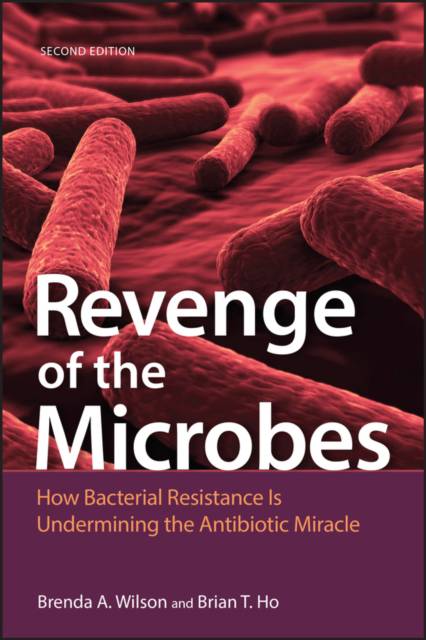
- Retrait gratuit dans votre magasin Club
- 7.000.000 titres dans notre catalogue
- Payer en toute sécurité
- Toujours un magasin près de chez vous
- Retrait gratuit dans votre magasin Club
- 7.000.0000 titres dans notre catalogue
- Payer en toute sécurité
- Toujours un magasin près de chez vous
Revenge of the Microbes
How Bacterial Resistance Is Undermining the Antibiotic Miracle
Brenda A Wilson, Brian T HoDescription
"What is antibiotic resistance, and why should I care?"
Two decades after the first edition of Revenge of the Microbes: How Bacterial Resistance Is Undermining the Antibiotic Miracle warned of the looming threat of antibiotic resistance, it is now upon us. Not only has the spread of antibiotic resistance continued unabated, but the emergence of multidrug-resistant "superbugs" is poised to set medical progress back centuries. Several distinct biological, social, economic, and technological factors have resulted in us only barely keeping pace with these new threats.
In this edition of Revenge of the Microbes, the authors detail the intricacies of the antibiotic-microbe arms race. Beginning with a historical perspective on antibiotics and their profound impact on both modern medicine and present-day society, they review our current arsenal against infectious diseases and the various ways pathogens evade or overcome them. The authors examine the practices and policies driving the discovery and development of new antibiotics, what happens to antibiotics once they are released into the environment, how antibiotic-resistant bacteria evolve and spread, and the urgency for finding alternative approaches to combating infections. This discussion of the controversies surrounding antibiotics will empower readers--citizen scientists, policy makers, pharmaceutical researchers, and medical professionals alike--to generate informed opinions on antibiotic usage and stewardship as we contend with fewer effective antibiotics.
Reader-friendly and comprehensible, this new edition of Revenge of the Microbes engages a diverse audience of scientists, clinicians, educators, students, lawyers, environmentalists, and public health advocates as it explores the ever-changing landscape of the antibiotic resistance crisis.
For anyone interested in antimicrobial resistance (AMR), this is a completely approachable 360-degree view of a very complex topic. The authors don't dilute the science but manage to deliver it in language and examples that everyone can digest. Don't miss the "Points to Ponder" at the end of each chapter. These thought-provoking nuggets will inspire creative thinking even in the most experienced AMR authorities.
-- JEAN B. PATEL, PhD, D(ABMM), Principle Scientist, Scientific Affairs, Microbiology, Beckman Coulter; former Science Team Lead, Antibiotic Resistance Coordination and Strategy Unit, CDC
Revenge of the Microbes: How Bacterial Resistance Is Undermining the Antibiotic Miracle, 2nd edition, by Brenda A. Wilson and Brian T. Ho, is an intriguing and detailed narrative of the history of antibiotics, the mechanisms by which bacteria become resistant, and the spread of antibacterial resistance across the globe (Figure). The second edition comes at a critical time. While the attention of the general public, medical communities, and pharmaceutical companies is understandably focused on the development of vaccines and antivirals in response to the COVID-19 pandemic, this book shifts attention back to the ongoing crisis of antibiotic resistance.
The authors present readers with points to ponder, summarizing critical facts and discoveries while highlighting important unanswered questions at the conclusion of each chapter. That section provides an opportunity to pause, digest the material, and critically consider the potential impact of the "revenge of the microbes."
Revenge of the Microbes offers an insightful examination of a critical global public health threat. This text succinctly meets the objectives outlined in the preface, focusing on "bridging the informational divide by presenting a more holistic view of antibiotics and antibiotic resistance." This book offers the opportunity for a general audience, including students, educators, scientists, medical professionals, and concerned citizens, to gain an appreciation for the successes of antibiotics and understand the intricacies of antibiotic use and stewardship.
CARUSO I. Revenge of the Microbes: How Bacterial Resistance Is Undermining the Antibiotic Miracle, 2nd Edition. Emerg Infect Dis. 2024;30(11):2453.
Spécifications
Parties prenantes
- Auteur(s) :
- Editeur:
Contenu
- Nombre de pages :
- 176
- Langue:
- Anglais
- Collection :
Caractéristiques
- EAN:
- 9781683670087
- Date de parution :
- 11-04-23
- Format:
- Livre broché
- Format numérique:
- Trade paperback (VS)
- Dimensions :
- 148 mm x 226 mm
- Poids :
- 317 g







